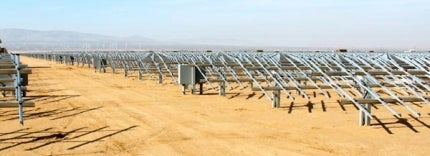
The Antelope Valley Solar Ranch One (AV Solar Ranch One) is a 230MW solar photovoltaic (PV) power project being developed in the Antelope Valley in North Los Angeles County of California, USA.
The construction of AV Solar Ranch One has been underway since August 2011. The project is expected to begin full commercial operation by the end of 2013. The power generated by the project will be enough to meet annual electricity needs of as many as 75,000 homes.
Exelon Corporation is the owner of the AV Solar Ranch One project. First Solar will build, operate and maintain the facility. The total investment on the project is estimated to be $1.36bn.
The project is expected to create 400 construction jobs and 15 operations and maintenance jobs.
AV Solar Ranch One project development details
The AV Solar Ranch One Project was originally to be developed by NextLight Renewable Power. Planning for the project started in 2009. The project obtained provisional permission from statutory authorities in 2010.
First Solar took over the project following its acquisition of NextLight Renewable Power in July 2010. First Solar got final environmental approval for building AV Solar Ranch One in January 2011.
Exelon Corporation acquired the AV Solar Ranch One project in September 2011. First Solar will continue to be the developer of the project.
Financing AV Solar Ranch One
The US Department of Energy’s Loan Programs Office guaranteed a loan facility of up to $646m to support the building of AV Solar Ranch One in September 2011. The first advance of the guaranteed loan for the project was received in April 2012.
Exelon is planning to invest up to $713m in equity in the project in 2013.
AV Solar Ranch One project site
The solar project is being built on 2,100 acres of crop-free farmland near Lancaster, in the Antelope Valley area of the Western Mojave Desert. The site is located about 80 miles (128.7km) north of Los Angeles.
The location was selected for its quality solar resource and proximity to existing transmission lines.
AV Solar Ranch One plant make up
The solar farm will be installed with approximately 3.7 million ground-mounted PV panels. Attached to metal racks, the panels will not rise above eight feet from ground in order to resist the high winds of the region.
As of September 2012, one million solar panels were already installed at the solar farm.
Technology employed at AV Solar Ranch One
AV Solar Ranch One will have alternating-current (AC) photovoltaic (PV) modules. The solar farm will use First Solar’s FS Series 3 PV Module which features the latest advancement in thin film solar module technology.
First Solar’s FS Series 3 PV Module represents an advanced version of cadmium telluride (CdTe) thin film solar panels. The technology involves placing of a semiconductor compound formed from cadmium and tellurium (Cd-Te) as thin layers on to the surface of glass sheet.
The PV module has a length of 1,200mm, width of 600mm and thickness 6.8mm. A tracking system will tilt the solar panels as per the movement of the Sun.
The PV solar facility will be equipped with innovative inverters with voltage regulation and monitoring technologies, which will aid in improving its efficiency and reliability.
Power supply from the AV Solar Ranch One facility
The electrical output of AV Solar Ranch One will be fed into Southern California’s Whirlwind substation which is located about three miles (4.8km) north of the project site.
A power purchase agreement has been signed with Pacific Gas & Electric Company to sell the power generated from the project for 25 years.
Environmental impact of the solar farm in Antelope Valley
Related project
Agua Caliente Solar Project, Arizona, United States of America
Agua Caliente Solar farm is a 290MW photovoltaic (PV) power project being built in the east Yuma County of Arizona, US.
The solar plant does not use any water for electricity generation. With no air emissions, low visual impact and minimal noise, the facility does not have any significant negative environmental impact. On the positive site, the solar panels are planned to be recycled after their lifespan.
The project will reduce 140,000t of CO2 emissions annually while contributing to California’s goal of securing minimum 33% of its electricity from renewable energy sources.







